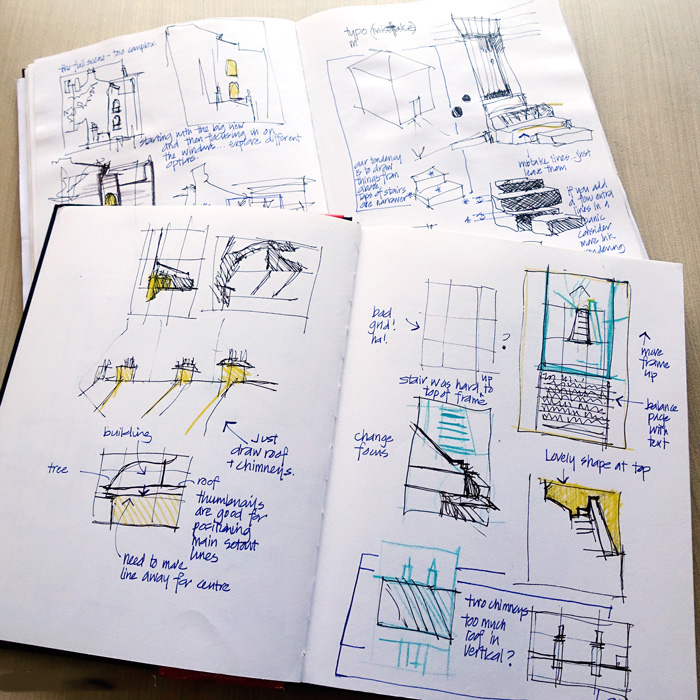
The final lesson in my Foundations course is all about reviewing your work and thinking about a few takeaways to focus on immediately. You can read more about it in last year’s article.
My three takeaways for this year are:
- How much I continue to get out of brushing up on the basics. There are so many different aspects to consider when creating a piece of art, that I don’t think you ever really get past the basic concepts. Constant reminders of the foundations are so helpful.
- How hard it is to stick to an online course but the discipline to keep going is always rewarded. This year I managed to stay on track until the OneWeek100People challenge and the following Sabbatical week. But as soon as I could, I got back on track. It has been tough for me to stick to doing the work, so I am pleased that I managed to reach the end. Even though some weeks it was a bit rushed, I still managed to gain some insights – ideas I wouldn’t have had if I had told myself “I’m too busy to do this!”
- How important it is to develop a habit of reviewing your work. I gave a few clues as to how I do this while reviewing 30 people’s artwork within Lesson 12. But as I was thinking about what things I look at when determining how successful a sketch is, I realised that SketchingNow Edges covers most of them. I’m looking for areas of distraction – either areas with too many lines or with too strong a contrast between shapes or colour. While accuracy is important, I believe these other aspects are more critical!
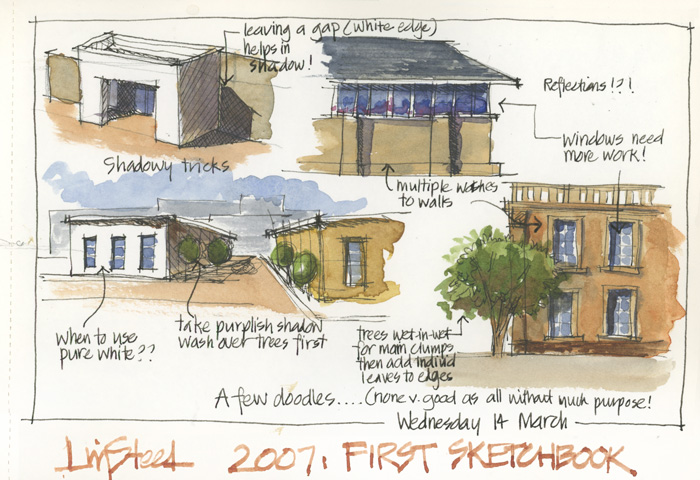
I have always had a habit of regular review and stocktake of my own work. To prove this, I want to share the last two pages of my very first sketchbook (from March 2007 – ten years ago). You can see that I wanted to summarise all the things which I had learnt in the course of filling up my first sketchbook.
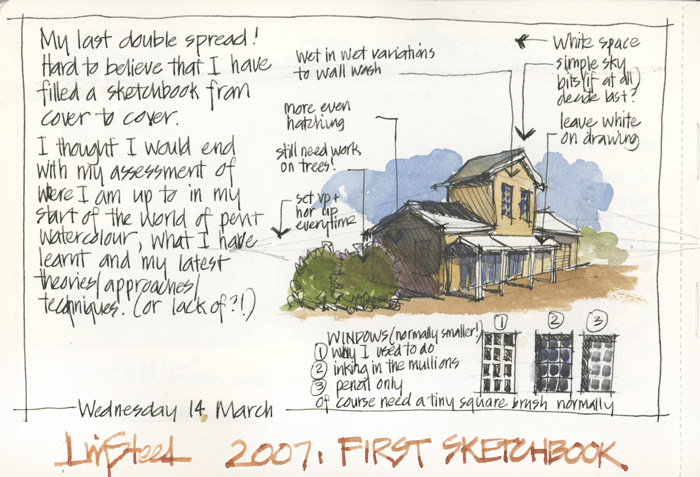
My sketches have changed a lot over the years but this discipline of super constructive self-critique hasn’t. If anyone struggles with the whole inner critic thing you might what to read my thoughts here and here.
Anyway, thanks for coming along with me on this Foundations Friday series. It’s been a lot of fun.
I am now seriously gearing up to open up the enrollment for SketchingNow Edges. If you are interested make sure that you sign up for the dedicated waiting list as there will be an exclusive introductory price for anyone on the list.
I would love to hear from anyone who has been working through Foundations since January. How did you go? or How is it going?




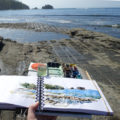
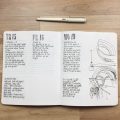

8 Comments
I love seeing these pages, Liz! It’s so nice to know that even you were a beginner once. 🙂 The notes are so helpful!
Have absolutely loved the Foundations course, slowly worked my way thru, your advice of looking at shapes, volumes and edges has been very helpful. But most “enlightening” were the exercises approaching a subject in different ways, not getting stuck on using a pen first, and then applying color ( indeed like a coloring book). I find myself now being much more comfortable using a quick aquarel pencil, use color (even outside the lines, haha!!! ) And use ink for some final touch up!! Have developed a looser approach which is exactly what I had hoped for … really appreciate the energy and upbeat attitude you bring to teaching!!!
Edges will be next, have your first edition ready to go…
I have worked through the foundations course (Dec 2016 started)-fantastic content & assignments. I am now conscious of good lines, working from a focus & the need to get out more to sketch in public. Looking forward to doing the foundation course again & beginning the Edges course.
Is the Foundations course necessary before one signs up for Edges? I’ve done a bit of painting (not huge amounts) over the past year, but am nowhere near being expert at technique! And yes, I’m on the waiting list for Edges.
Here is a long answer that I sent a few weeks ago to the waiting list:
I designed SketchingNow Edges to be an extension of Foundations – so to get the most of the course I highly recommend you not only review the Foundations lessons but also do the exercises. You only truly understand the concepts when you do the work.
The most important pre-requisite for Edges is to be comfortable enough with your own sketching so that you can suspend concerns about accuracy in order to focus on other art concepts. If you feel you are constantly stressed or distracted about your lines being perfect then you might not fully benefit from the more advanced content in Edges.
To help people decide whether they need to do Foundations, I have been going through each lesson on my blog under the Foundations Friday series. If have been sketching and painting for a number of years and are familiar with all the terms I refer to and have done similar kind of work yourself, then you will be able to do Edges without doing Foundations. However, in most cases it is best to do SketchingNow Foundations first.
Just for clarification: Foundations is a mutli-layered course, which means that it has content for both beginners and more advanced sketchers. On a personal level, I experienced a significant improvement in my own work while preparing the content for the course. I strongly believe that reviewing basic concepts is the best way to take your sketching to the next level. It’s easy to forget a concept you learned previously, and re-discovering it often leads to a richer application to your own work,
Hi Liz. I admire how you work and what impresses me more is that you not only sketch daily…you write daily about it. My question is how you manage and developed the habit of daily blogging about your sketches? Sometimes ithis is the most difficult part, the one that begins after you draw: choosing drawings, scanning and writing an interesting and well written post: this involves a lot of time and organization. How do you manage this? Do you have a schedule for this post-sketching part? What is your WHY for this? Does the task of writing a daily post motivates you to sketch more? Almost nobody of the urban Sketchers blog daily…how did you conquer this task?
Erika Brandner
Urban Sketchers Chile
Hi Erika – thanks so much for your kind words. Two main thoughts. 1. I am an architect and the biggest part of our job is to produce drawings and then write about them – explain them to the client. So it is ingrained in me to write about my drawings. 2. Following on from that is the idea that this writing became part of the process of sketching for me…and particularly because I was so encouraged by the comments in the old Flickr days. So I don’t see it as an extra chore – in fact I almost feel a sketch is incomplete if I don’t share it. (third point I am trying to make a living out of sketching so its part of my work day. But I posted a lot even when I worked full time as an architect)
But in recent years my main WHY is that I want to inspire and help others by sharing my thoughts. I can’t do this as well if I just post my images with no text.
I am working on a map project in Charleston, SC that requires thumbnail sketches of (mainly) 18th century buildings. I did some drawings before the course from photos (because I wasn’t on location then) and, while they portrayed the buildings, they were pretty lifeless. So I googled “loose drawings” or some such and got to you and your course! It has been instructive and fun! And I see improvement, especially with angles, both with paper and iPad using sketches app (which may facilitate the final product on fabric. (Your suggestion to think of a clock face is genius.) My focus has been on sketching rather than watercolors (could use some more direction on that but that is another course). The buildings here are complex, not exactly beginner material, but they are the goal.
Some dumb issues, but issues nonetheless, are how to set up on location in order to have control over the lines. And—you probably won’t believe this one—whether to work front to back or back to front. In fabric, it is usually the latter, but if you sketch that way, you have things showing that shouldn’t be! Figuring out how much to set up is an interesting and illuminating challenge.
In summary, I have loved the course and the blog. Thank you!
NEWSLETTER
Subscribe for first notification of workshop + online classes and more.